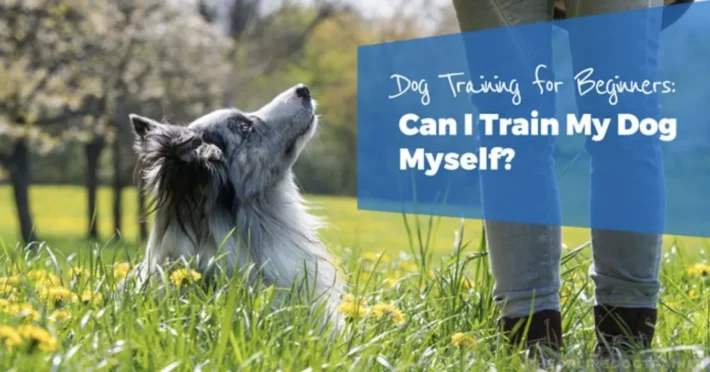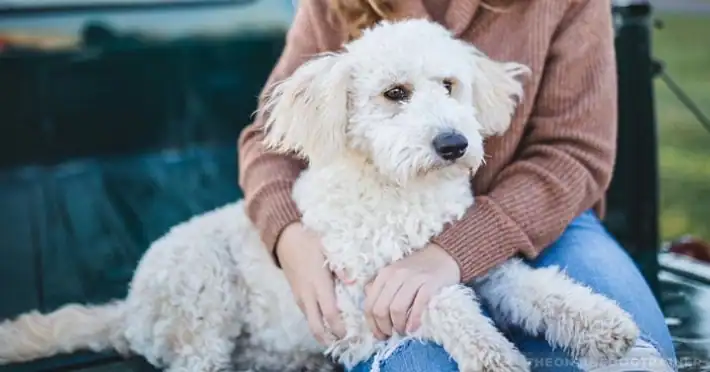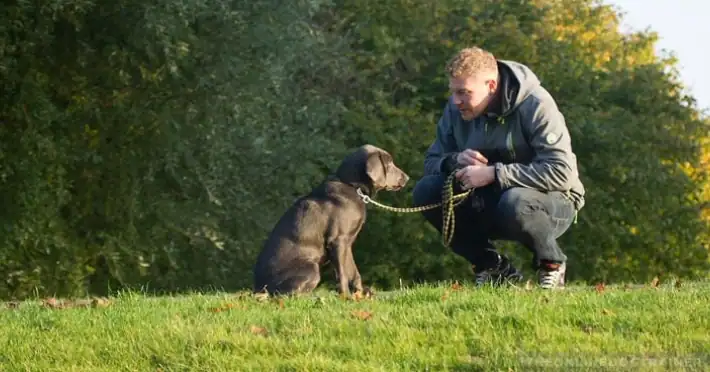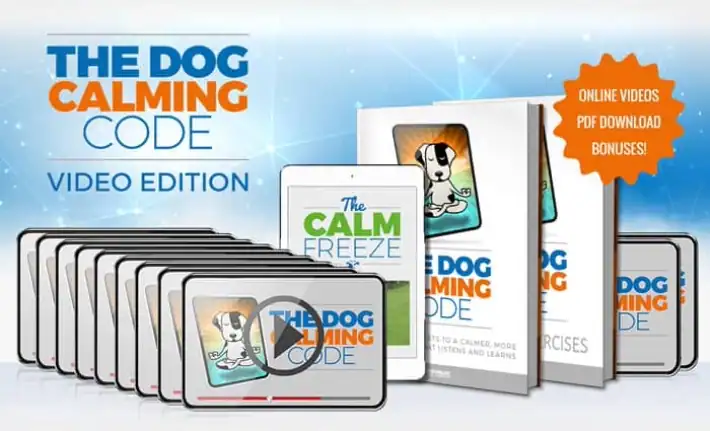“Can I train my dog myself? Can I train my dog online?” If you find yourself asking this question, this blog will answer it.

Just the other week I answered a question I often get asked…
“Does my dog need obedience school?”
If you read the post and came to the conclusion that obedience school isn’t the right choice for your dog, you may now be wondering, “Can I really train my dog myself?”
My answer, in short, is “ABSOLUTELY”!
In fact, I encourage dog owners to take the reins and train their dogs themselves.
Why?
Training your dog (using the correct methods) is a foundational part of building a trusting relationship between you and your pup. You can also have a lot of fun and save a lot of money in the process!
But what if you don’t have any dog training experience? Perhaps you’ve just brought home your first puppy ever.
That makes you a beginner dog trainer and that’s 100% okay!
How do I know you can do it? Because training your dog really boils down to building a healthy relationship with him or her. And that’s fairly easy to do when you have the right tools.
What do I mean by “healthy relationship,” and what tools do you need? Let’s dive deeper into what I mean by that now…
JOIN THIS FREE CLASS TO TRANSFORM YOUR DOG IN JUST 7 DAYS!Key Takeaways
- You're More Capable Than You Think! Don't let a lack of experience stop you; you absolutely can train your own dog. It's an empowering and rewarding journey that strengthens your bond.
- It's All About Connection, Not Just Commands. Before “sit” and “stay,” focus on becoming your dog's trusted leader. Understanding their world and earning their respect is the true foundation for effective training.
- Equip Yourself for Success. While a solid training program like “The Dog Calming Code™” is your most vital tool, having a few key items—like leadlines, tasty treats, a crate, and a good harness—will truly set you up for a smooth and enjoyable training experience.
Dog Training for Beginners 101: Establishing a Healthy Relationship with Your Dog
First, let's talk about why snappy dogs are unique dogs, especially when it comes to aggression.

When you think of training your pup you’re probably thinking about teaching them commands like sit or stay. Sure, that’s part of dog training, but before you get that far you must understand a much more important dog training component.
That component is learning how to gain your dog’s respect and trust so that they will listen to you!
Learning how to gain your dog’s trust and respect is something YOU must learn as your dog’s “leader.” Therefore, the dog training process begins with training yourself!
The reality is that your dog doesn’t care…
- How big your house is.
- What kind of car you drive.
- What you do for work.
What is important to them is who controls the important things like…
- Where the food comes from.
- Playtime.
- Having a safe spot to nap and relax.
Food, of course, is usually the most important thing on that list!
Do you see how our human mind and your dog’s mind are focused on very different things?
To train your dog, you have to think like your dog and tap into the psychology of what matters most to them. Until you do this and establish yourself as the trusted leader of your “pack,” no type of training is going to be very helpful.
So, how do you build that type of relationship with your pup?
I’ve taught over 50,000 people how to do it with my program, The Dog Calming Code™!
Learn more about what’s inside the Dog Calming Code™ here!
Can I Train My Dog Online?
The answer to whether you can train your dog online is a resounding “ABSOLUTELY!” In fact, the very program I mentioned, “The Dog Calming Code™”, is designed to be an online resource.
The beauty of online dog training is that it empowers you, the owner, to take the reins from the comfort of your own home. You don't need prior experience; the crucial element is a willingness to build a healthy relationship with your pup.
Online programs, particularly those with a strong foundational approach like “The Dog Calming Code™,” provide the tools and guidance you need. They often come with step-by-step video tutorials and comprehensive instructions, allowing you to learn at your own pace and apply the methods directly with your dog in their familiar environment. This not only makes the process convenient but also reinforces your role as the trusted leader, which is fundamental to successful training.
So, if you're ready to dive in and transform your relationship with your dog, online training can be a fantastic and effective path forward!
REGISTER HERE AND GET THE DOG CALMING CODE FOR FREE!Dog Training for Beginners: Important Tools for your Training Toolbox

Now you know the secret to successfully training your pup and have the confidence to train your own dog! Brilliant!
Now, what do you need to have on hand to ensure your training plan is a success?
By far the most important tool you need is a solid dog training program (like the Dog Calming Code™ program I just mentioned above).
This is especially important if you’ve never trained a dog before.
Not only will my Dog Calming Code™ training program teach you to train your dog to do things like sit, stay, and come when called but it also helps you build the very important relationship foundation we discussed earlier.
If you really want to connect with your dog on a deep level so that your pup will listen to you when it matters most, I urge you to check out the dog training program now!
Learn more about my Dog Calming Code™ program here!
In addition to the program, there are a few additional tools that I recommend you have ready in your dog training tool belt.
Here’s a quick overview of what I personally like to keep on hand…
Leadline: Leadlines are great as they allow you to give your dog freedom while still having control, such as when socializing your pup with new playmates or working on recall commands.
Training treats: Food is a fantastic motivator. As long as your training approach isn’t reliant on treats, having some delicious morsels on hand can make the process much easier.
Crate: On top of being a safe space for your dog, crates make wonderful “time out” areas for when you need to help your pup calm down and refocus.
Harness: A harness is a great tool for teaching dogs to walk nicely on a leash.
Toy: Instead of using food as a reward you can always substitute your pup’s favorite toy. After your dog listens to you, indulge in a little game of fetch or tug.
Whistle/Clicker: Some dogs respond well to audible cues, such as blowing a whistle to come or waiting for the sound of a clicker after performing a trick. These items aren’t 100% necessary but might be worth a try!
Not sure what to do with all of these training tools or how to use them?
Not to worry!
My Dog Calming Code™ program walks you through how to use all sorts of training tools in easy-to-watch step-by-step videos so you can see firsthand how I calmly and gently train dogs.
I’m so confident my program WILL enable you to train your dog from the comfort of your own home that I offer a 60-day money-back guarantee!
So, what are you waiting for?
Check out my Dog Calming Code™ and get the knowledge you need to train your pup from home starting today! I know YOU can do it!


~Doggy Dan 🙂







2 Responses
Which program helps with jumping on people, licking people or trying to take their shoes while they’re wearing them!
Hi Chrissy…yes, these are common issues indeed! Depending on the age of your dog/puppy we have a program that will help. In fact we have topics relating to each of the issues you mention. Head to my website TheOnlineDogTrainer.com and take a quick look…it’s a $1USD trial for 3 days…All the Best, Doggy Dan